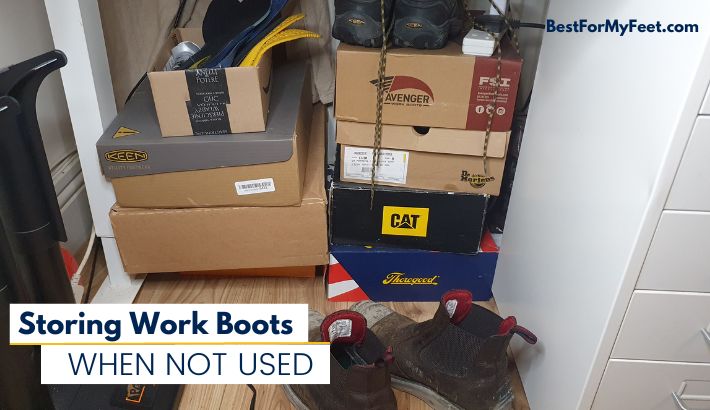This article is going to talk about some ways to store your work boots when not in use. You might ask if it’s important where work boots are stored.
You probably just fling your boots in the corner when you get home, or leave them in the garage or workshop.
But there are some things to think about to maintain boot longevity, hygiene, and practicality. Things like boot rotation, ventilation, hydrolysis, fungi, etc.
Stick around and find out.

Why is the location of boot storage important?
Before you can get the proper context of where to store your work boots, let’s highlight some reasons why the location where you store them is important.
1. Moisture
Whether you put your work boots away ready for the next day, or you want to store them for rotation or during a change of season, there are certain elements that can be detrimental to the boots.
Moisture is a key factor. Boots are often exposed to it via our sweat, rain, and humidity in the air.
I’ve stated in a few BestForMyFeet articles already that although water is vital for survival, it can also cause erosion of materials, and it carries and breeds bacteria.
There are lots of examples of erosion that can give you a clear picture of what I’m talking about.
Puddles of water or heaps of snow that collect on roads eventually eat away at the tarmac and concrete, creating those nasty potholes.
Also, rainwater that runs down mountains and streams eventually corrodes rocks and cliff edges, causing cracks, mudslides, avalanches, and more.
With regards to bacteria. If it’s left in stagnant water, it will multiply. This is sometimes how food poisoning comes about.
Now, I get these points have nothing to do with your work boots, but I’m just explaining the principle and some of the science behind how detrimental the moisture that stays on your boots can be.
2. Boot rotation
Boot rotation, for those of you new to work boots. is the process of wearing your boots for a certain amount of time, then swapping them for other boots for a while, then swapping back. This is done for a variety of reasons.

You might wear winter work boots with insulation in extreme cold, then have to swap them for work boots suitable for summer.
You might do multiple trades or jobs that each need specific boot requirements.
You might get new boots that take a painfully long time to break in.
Wildland firefighting boots for example. Some logger-style work boots are said to take a minimum of 300 brutal hours to break in. The process of swapping the boots around can give your blisters a chance to heal.
You might need your boots repaired or rebuilt, so would need a temporary replacement.
There are lots of reasons for rotation. But the bottom line is, you need to store the boots that are not being worn.
3. Fungus/Bacteria
Who in their right mind wants smelly feet? Certainly not me.
Well, storing your boots (especially if they’re full of sweat or are not clean) in damp or unventilated areas is a sure way to help bacteria grow in them. The bacteria can turn into certain fungi.
This situation gives the risk of giving you either smelly feet (link to how to sweat or smelly boots), or if you have existing foot conditions like Athlete’s Foot, it can make it worse.
So, dark unventilated areas are the kind of places that Mr. Fungus loves to do his dirty work.
Adrian from the editorial team had a lot of issues with this and he wrote a few articles about getting rid of Athlete’s foot fungus using hydrogen peroxide and similar and he also put together a video on how he’s disinfecting his work boots.
4. Boot hydrolysis
Oh good, I get to talk about moisture again. Moisture, as well as excessive heat, can cause hydrolysis in boots if they’re left for long periods.
In simple terms, hydrolysis is the acceleration of the aging process. The boot materials break down at a molecular level.
I know you like examples. Allow me to give you one.
You know when you leave a bicycle or car standing for a long time, and when you go back to it, the tires are flat and all cracked?

These tyres are now pretty much useless, so need replacing. It’s the same with football’s, car window seals, etc.
It’s definitely the same with boots. When the boots are left for a long time in areas of moisture or areas where there is excessive heat, like intense sunlight, hydrolysis likes to target the leather (if they have any) and Polyurethane (PU) outsoles.
5. Space
If you live in a home with limited space, the added stress of keeping your work boots somewhere can be a nightmare. Especially if your household is anything like mine.
We have a shoe cupboard that is overflowing with footwear. I’ll add that only a handful of them are mine. The kids’ collection is ever-growing. But the wife. Don’t even get me started with that one.
Here’s how to store your work boots and why
1. Storing your work boots for long periods
Here we detail some things to think about if you want to store your boots for a long time.
Clean them first
If you want to put your boots aside for a while for whatever reason, the first thing you need to do is clean them inside and out. Disinfecting your work boots before storing them is a good practice.
This will help prevent bacteria from growing while they’re stored. Especially in a confined space.
Condition the leather
We also advise conditioning your work boots if they are leather. This will help keep the leather hydrated and supple while they’re stored, instead of drying out and possibly cracking.

There are lots of products to apply to the leather.
A lot of people like to use mink oil but there are other products such as boots oil, wax, and others. Check out our mink oil vs boots oil article if you want to learn more about these two products.
Avoid dark rooms
Most fungi don’t need darkness to grow, but they are known to grow much quicker in the dark than in the light. It’s because of that dreaded moisture.
Light tends to dry out the moisture that fungi need to grow.
Stashing your work boots away in places like sheds, garages, or attics are not going to give them enough light and warmth to rid the moisture.
Shoe trees
When you return to the boots to start wearing them again, you’ll want them to still have the shape that’s served you so well. One way of preserving that shape is to store them with shoe trees inside.
Even better, cedar wood shoe trees are designed to soak up moisture from the boot.
If you don’t want to, or can’t afford to buy shoe trees, you can stuff the boots with newspaper. With tall boots like cowboy boots, you can roll the newspaper up and put it in the shaft.
Keep them off the ground
Not only is the ground cold, it often holds a lot of moisture. So it’s best to store your work boots off the ground.
You can do this by using things like boot racks, boot hangers, or shelves. This also keeps them tidy, organized, and out of the way.
If using shelves, make sure the space between the shelves are big enough to house tall boots, and have enough area to provide each pair of boots with air space.
If you want to keep them inside the house, you could place door mats, old newspaper, towels, or anything like that on the shelves and floor to protect from any dirt, oil, or chemicals that might be on the boots.
Boot boxes
It’s a good idea to keep the boxes that the boots came with, so that you can store the boots in them for long periods. That way, elements like dirt, dust, or moisture won’t get to the boots.
It’s also a good way of keeping all of your boots tidy and together. You can stack all your boots on top of each other.

Silica gel packs
You could keep silica gel packs in the boots when storing them for a long time. Particularly if storing them in boxes.
This is a method used by manufacturers and retailers to absorb moisture.
2. Store your work boots between shifts
This could mean overnight or if you do night shifts, any time that you leave them before starting your next shift.
It refers to short periods, where you’ll need to get to the boots regularly.
Unlike when storing for long periods, cleaning and disinfecting them daily isn’t very feasible. It’s not as important anyway, because you’ll soon be wearing them again.
With regular use, a good clean every now and then should suffice. Unless of course, they get extremely dirty at work.
Dry your work boots
Your boots can get exposed to all kinds of moisture while being worked. Whether it’s rain, sweat, or work-based spraying.
As you know by now, it’s important to dry this moisture, so as not to accumulate bacteria. Not only that. Nobody wants to put on wet boots when they start work.
Gentle heat is a good option. You don’t want too much heat, otherwise, it can dry the boots too much, accelerating hydrolysis.
You can leave them near a heater or radiator. Preferably not too close, or on top of heaters, because this could cause them to burn, or worse, create a fire.

Electric boot dryers are a great option. They’re not expensive and are specially designed purely for that purpose. The one used in the image above is the PEET Original boot dryer.
You can also stuff the boots with newspaper to help soak up the internal moisture.
Charcoal bags
Another way of both drawing unwanted moisture out of your boots and drawing external moisture away from them is by storing them near bags of charcoal.
The charcoal has a knack for absorbing moisture from the atmosphere.
Ventilation
With regular use, you’ll likely have all sorts of bacteria on your boots. They’ll contain your sweat, along with whatever else they pick up on their way.
So after your working day, make sure to store them in well-ventilated areas. Particular when drying them.
This should help avoid bad smells in your work boots. And it will also help moisture escape the area in which they’re being kept.
Boot room/mudroom
Some people have a specific room where they keep all their boots. Whether it’s a spare room, a large walk-in cupboard, a pantry, a porch, a conservatory, or a lobby at the front or back of the property.
This is usually an area that doesn’t matter if it gets dirty. It’s best suited near the entrance of the property so you can get easy access when rushing out the door, and can kick the boots off when you get home, before stepping inside into the clean.
Ideally, this space should have heating to dry your boots when they’re not in use. And it’s best suited to have windows to get sunlight in. And ventilation to allow the boots to breathe and let moisture and smells escape.
Protect floors or shelving
As stated in the ‘Storing for long periods’ section, it’s a good idea to protect the surface that you keep the boots on.
This is even more important when storing everyday boots because these boots will be much more likely to bring home substances from your work.
There could be substances like dirt, mud, and concrete on them. Or even more hazardous substances, like oil, acid, or other chemicals. You should attempt to clean the more hazardous substances off at work. But it’s not always possible.
Protect your animals and children
If you can’t clean hazardous substances off your boots at work, try to store them away from where pets or children can get to them. Maybe in a locked area, or high up where they can’t be reached.
3. Store your work boots in a home with limited space
It’s all good and well giving you all these ideas about storing your boots, but what if you don’t have much space at home to store them? You might live in a small apartment.
You might be like me and have kids and a wife who takes up every inch of space. Or you might be a hoarder who has clutter everywhere.
So, what do you do?
Commercial boot storage
These are units or stands that have rows of pegs or arms that stick out so that you can put your boots over them, usually upside down
Boot rack
Most households have these. They’re shelved units that can hold multiple pairs of boots.
Peg rack
You can buy these or you can make your own by inserting long wooden dowels into a flat piece of wood, then stand it so they are pointing upwards.
Or you could cheat by taking a wall-mounted coat rack off the wall and putting it on the floor. The boots sit upside down on the pegs.
Crates
These are essentially open-sided boxes that you stand on edge, then stand your boots inside. The crates can be stacked up beside and on top of each other.
The open face gives the boots sufficient breathing space and allows you easy access.
You can buy crates, or ask local shops if they have any they don’t need. Failing that, they’re easy enough to make.
Boot boxes
We touched on this earlier. If you keep the boxes that the boots came in, they’re a good storage space to stack on top of each other.
Boot hangers
This one is a little unheard of. There are hangers that you can buy that are specifically for boots.
Or you could cheat by using a binder clip (in England we call them Bulldog clips) to hold the boots together at the top, then run the hook of a normal clothes hanger through the clip’s hole.
So, in effect, the boots will be hanging on the clip, the clip will be hanging on the hanger, and the hanger on anything available.
If you have a rail or some hooks somewhere, then you can hang your boots off the ground. This way, they don’t take up floor space, and get good ventilation around them.
4. Storing rubber boots
I thought I’d add a little summary for storing your rubber boots.
Storing them doesn’t need to be quite as meticulous as with leather or fabric boots, because moisture doesn’t soak into them unless it has a lining. Although, hydrolysis still takes hold.
You can store them using any of the tips stated above, but they are more suitable outside. Not for long unused periods though because of the hydrolysis.
If you do store them outside, keep them close to a wall to minimize sunlight and rainfall. And store them upside so as not to get rain in them. This can be done using commercial boot racks or upright boot pegs.
The final word on storing work boots
That just about sums everything up. Before writing this, I didn’t think there would be so much to think about in terms of storing boots.
But the research was a real eye-opener. Thinking about it now, a lot of it comes down to common sense.
You shouldn’t go too wrong if you think about these key points:
- Try to keep the boots clean
- Avoid too much intense heat
- Avoid too much moisture
- Seek ventilation
The resources that I’ve mentioned to assist with your boot storage are all affordable or easy enough to make if you’re good with your hands.
That’s all from me now. Hopefully, you’ll come away from this with some useful ideas.
Take care of yourself.
Team Members Working On This Page

Jimmy Webb – Writer And Researcher
Hey, Jimmy here. I’m one of the researchers and writers here at BestForMyFeet.com. I’ve been wearing work boots all my life working as a forklift driver, landscaper, groundworker, and now as a tower crane operator so I know a few things about footwear and footcare in general. I’m also working on my first novel. So writing IS my passion. When I’m not writing I love to spend time with my wife, two children, and furball.

Victor Adrian – Editor And Webmaster
Construction Professional, driver, crane operator, cleaner, head chef … these are just some of the jobs I did in the past. Working in all these different environments taught me that having good footwear to protect your feet from different dangers at work IS PARAMOUNT for any worker! On this website, I aim to share all my knowledge and personal experience in dealing with different footwear and foot care issues, and hopefully, you can get something out of it. Enjoy!
source https://bestformyfeet.com/where-to-store-work-boots-when-not-in-use/

No comments:
Post a Comment